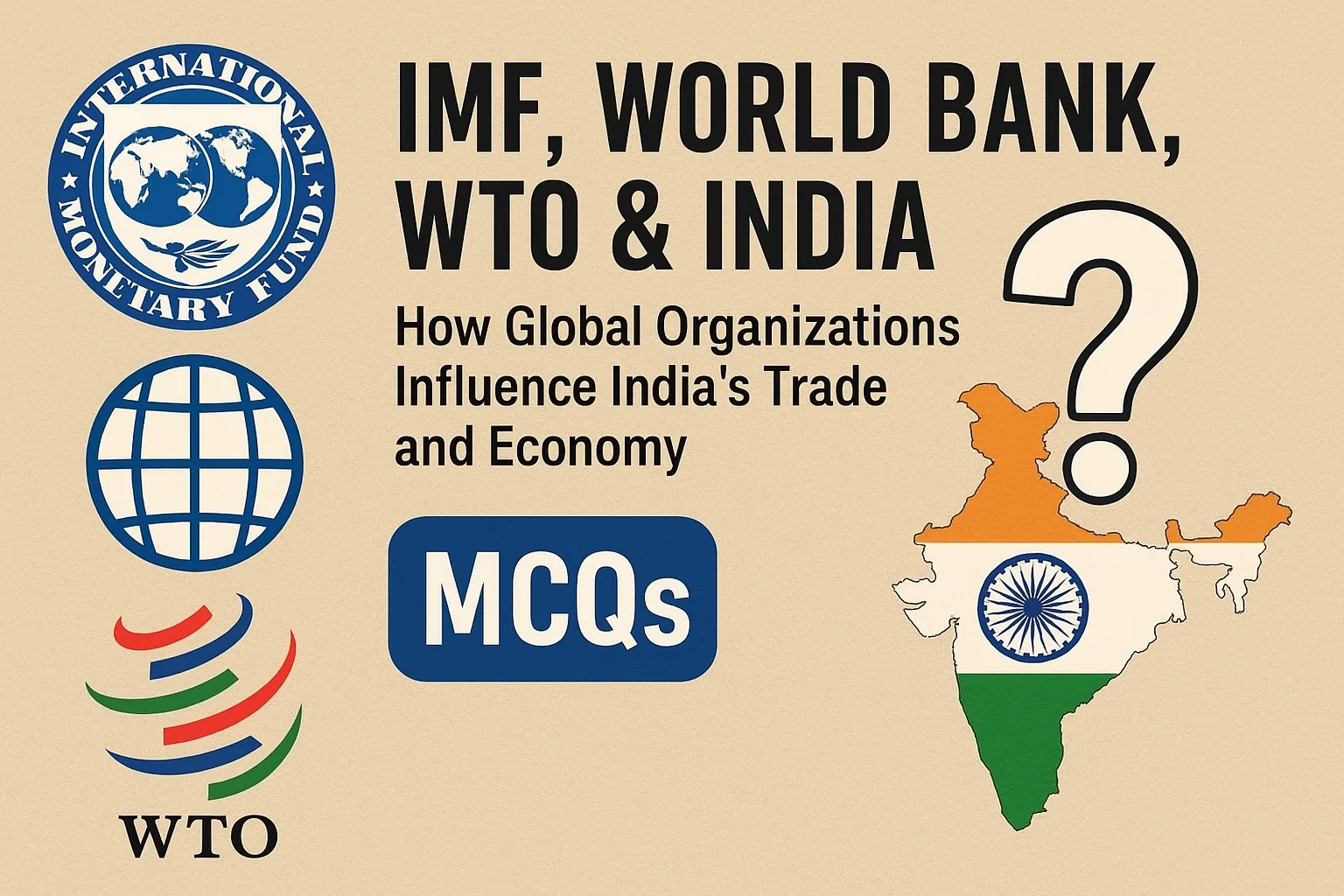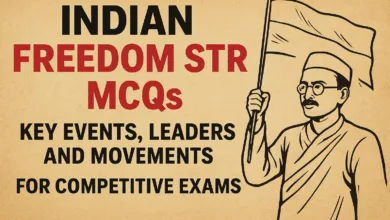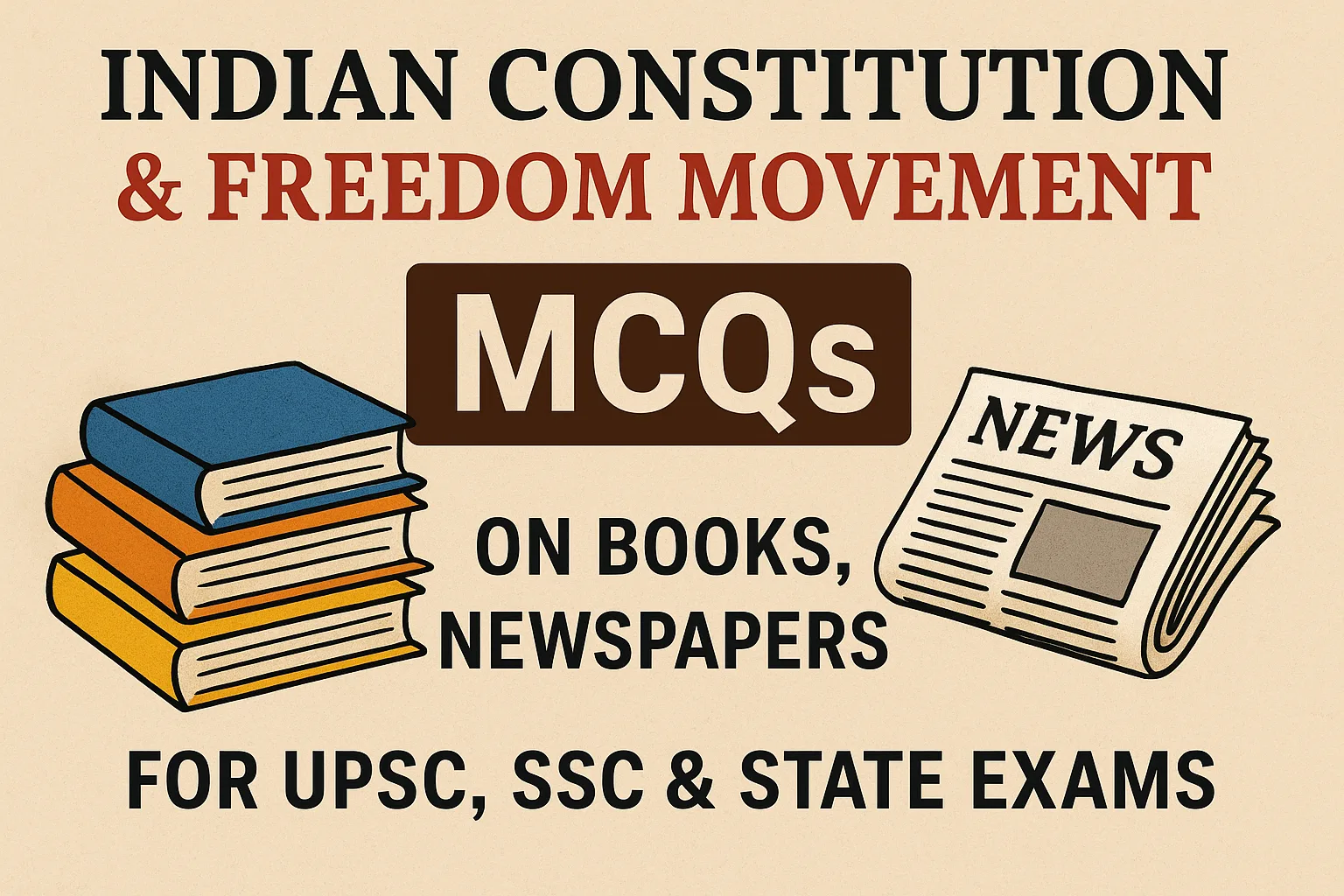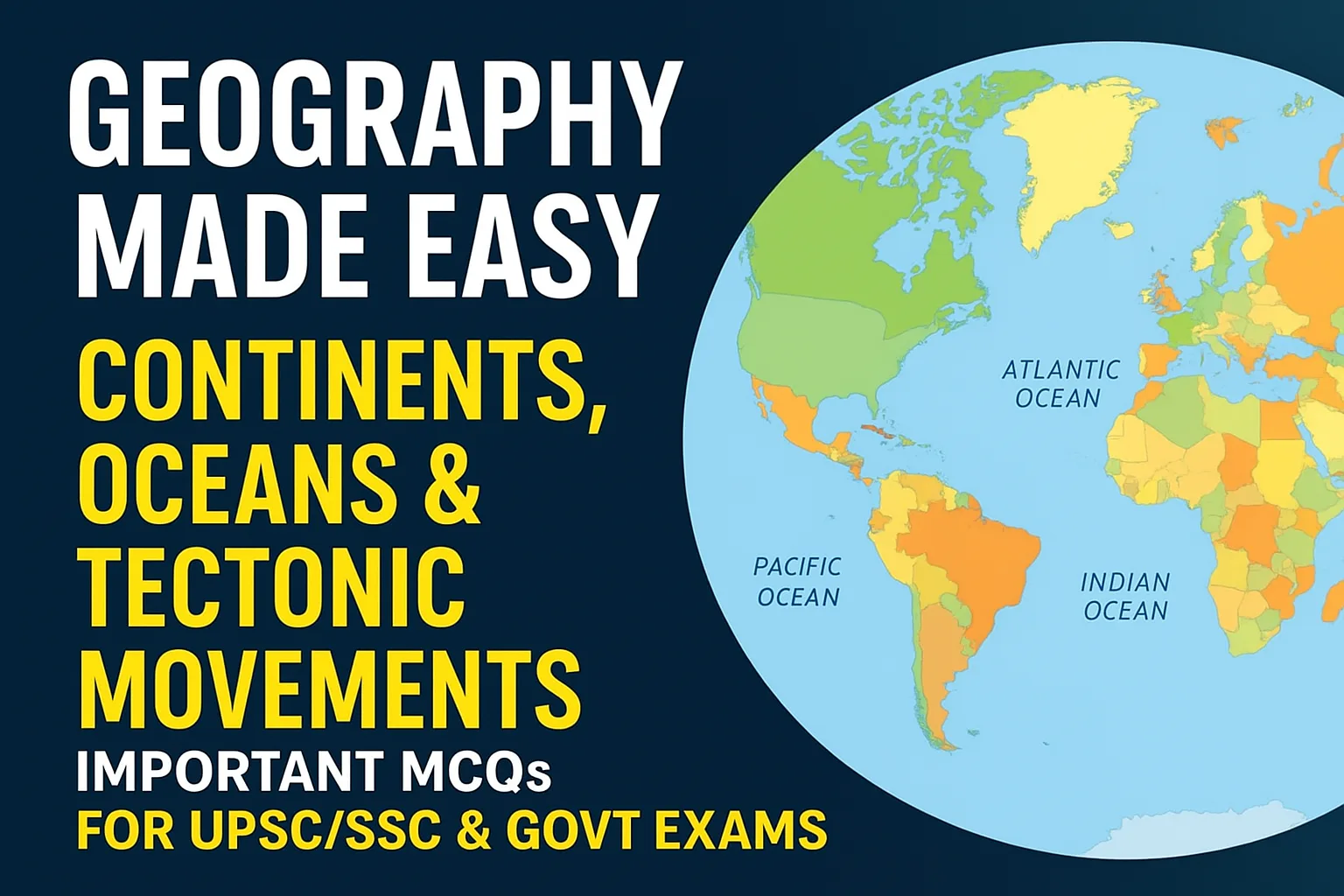Mineral and Energy Resources of India: MCQs with Answers for Railway, Banking and other Competitive Exams
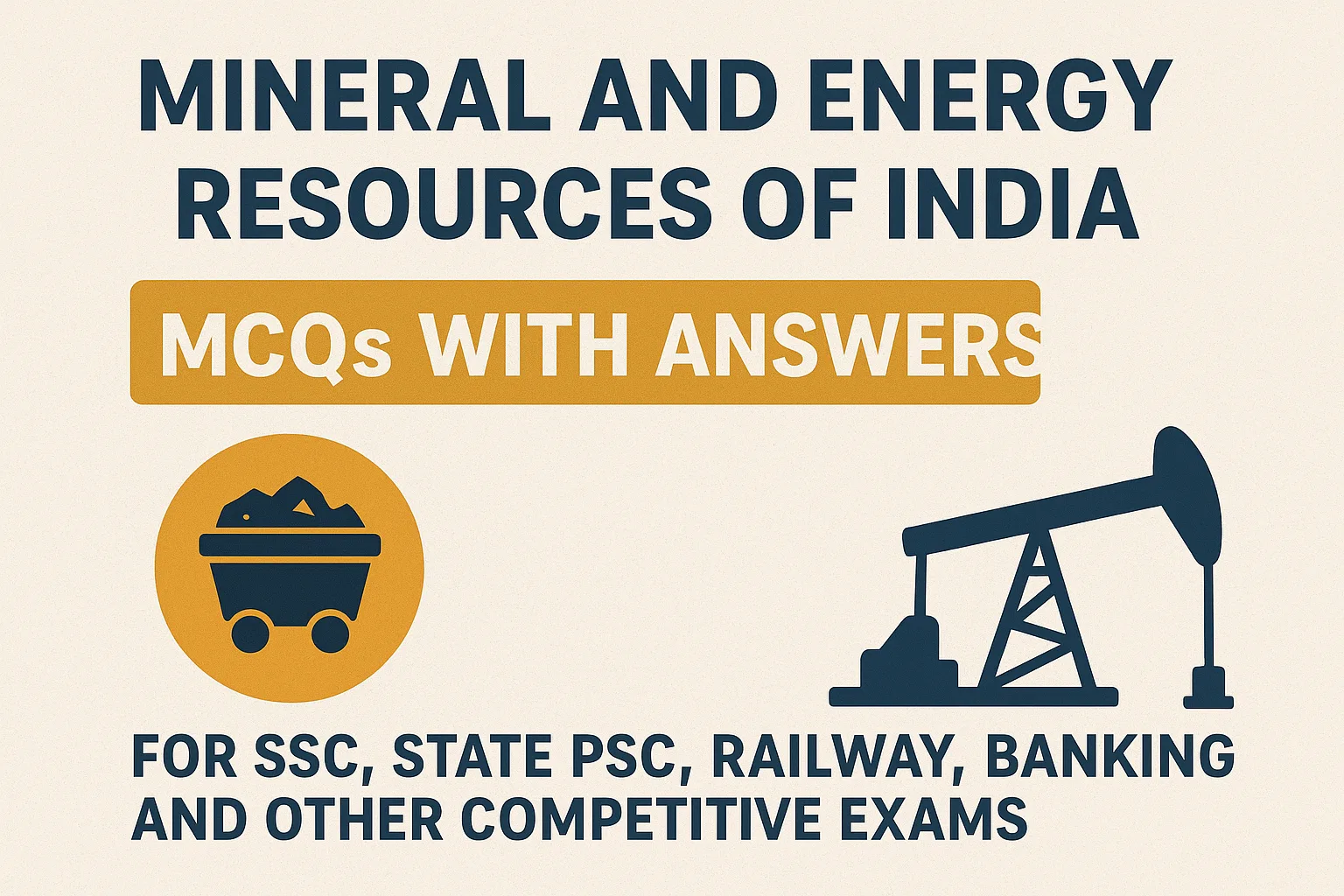
Mineral and energy resources are very important for India’s economic growth and industries. Energy resources, both traditional and new, give the power needed for progress, while minerals provide raw materials for industries like steel, aluminum, electronics, and power. For exams, it is important to know the types of energy sources, kinds of minerals, how they are extracted, and where the main mineral deposits are found in India. The MCQs below are made to check your knowledge of these topics in a simple and clear way.
Energy is defined as the ability to do work. Which of the following best represents conventional sources of energy that are limited in quantity and considered non-renewable?
a) Solar energy, Wind energy, Tidal energy
b) Firewood, Coal, Petroleum, Natural Gas
c) Geothermal energy, Bioenergy, Tidal energy
d) Hydropower, Solar energy, Nuclear fusion
Answer: b) Firewood, Coal, Petroleum, Natural Gas
Which of the following is an example of non-conventional (renewable) sources of energy that are continually replenished by natural processes?
a) Coal, Petroleum, Firewood
b) Solar, Wind, Tidal, Geothermal
c) Nuclear material, Fossil fuels, Natural gas
d) Iron ore, Bauxite, Limestone
Answer: b) Solar, Wind, Tidal, Geothermal
Minerals are naturally occurring substances with a definite internal structure. The branch of science that studies the chemistry, crystal structure, and physical properties of minerals is called:
a) Geology
b) Petrology
c) Mineralogy
d) Metallurgy
Answer: c) Mineralogy
According to classification, minerals are broadly divided into metallic and non-metallic. Which of the following is a correct example of ferrous metallic minerals?
a) Copper, Bauxite, Zinc
b) Iron ore, Manganese, Nickel, Chromite
c) Graphite, Mica, Gypsum
d) Gold, Silver, Lead
Answer: b) Iron ore, Manganese, Nickel, Chromite
The Mohs scale of mineral hardness ranks minerals from 1 to 10 based on scratch resistance. Which mineral is the hardest and which is the softest on this scale?
a) Quartz hardest, Talc softest
b) Diamond hardest, Talc softest
c) Graphite hardest, Gypsum softest
d) Corundum hardest, Feldspar softest
Answer: b) Diamond hardest, Talc softest
The process of extracting metal ores buried deep underground is termed:
a) Quarrying
b) Drilling
c) Shaft mining
d) Mining
Answer: d) Mining
The process of extracting minerals near the Earth’s surface by cutting or blasting is called:
a) Quarrying
b) Open-cast mining
c) Shaft mining
d) Drilling
Answer: a) Quarrying
Which organization, established in 1972 and headquartered in Nagpur, is the premier agency in India for mineral exploration activities?
a) Geological Survey of India (GSI)
b) National Mineral Development Corporation (NMDC)
c) Mineral Exploration Corporation Limited (MECL)
d) Hindustan Copper Limited (HCL)
Answer: c) Mineral Exploration Corporation Limited (MECL)
The premier iron-ore exporting port of India is located in Goa. It is known as:
a) Vishakhapatnam Port
b) Marmagao Port
c) Paradip Port
d) Mumbai Port
Answer: b) Marmagao Port
In India, the largest reserves of iron ore are found in which state, making it the leading producer?
a) Karnataka
b) Odisha
c) Jharkhand
d) Chhattisgarh
Answer: b) Odisha
The Bailadila Hill Range in Chhattisgarh is famous worldwide for its:
a) Gold deposits of high purity
b) Very high-grade hematite iron ore
c) Largest copper ore deposits
d) Largest zinc and lead reserves
Answer: b) Very high-grade hematite iron ore
Which state has the largest reserves of magnetite iron ore in India, particularly at the Kudremukh mines?
a) Odisha
b) Chhattisgarh
c) Jharkhand
d) Karnataka
Answer: d) Karnataka
The primary ore of aluminum and the chief raw material used in aluminum smelters is:
a) Cryolite
b) Bauxite
c) Kaolinite
d) Corundum
Answer: b) Bauxite
The largest producer of bauxite in India is Odisha. The most important bauxite deposit here is found in:
a) Sambalpur district
b) Panchpatmali hills in Koraput district
c) Lohardaga region of Jharkhand
d) Kalahandi plateau
Answer: b) Panchpatmali hills in Koraput district
Which state in India has the highest production of manganese ore, even though Odisha has the largest reserves?
a) Odisha
b) Maharashtra
c) Madhya Pradesh
d) Jharkhand
Answer: c) Madhya Pradesh
The largest copper mine in India, Malanjkhand, is located in which state?
a) Jharkhand
b) Rajasthan
c) Madhya Pradesh
d) Odisha
Answer: c) Madhya Pradesh
The town of Khetri, famous for copper mines, is located in which district of Rajasthan?
a) Ajmer
b) Udaipur
c) Jhunjhunu
d) Jodhpur
Answer: c) Jhunjhunu
The world’s primary ore of lead, also occurring in Rajasthan mines, is:
a) Zincite
b) Galena
c) Calamine
d) Sphalerite
Answer: b) Galena
India’s largest zinc and lead mine, Rampura Agucha, is located in which district of Rajasthan?
a) Udaipur
b) Jodhpur
c) Bhilwara
d) Ajmer
Answer: c) Bhilwara
Which state hosts the largest uranium reserves in India, specifically at Tummalapalle?
a) Jharkhand
b) Odisha
c) Andhra Pradesh
d) Rajasthan
Answer: c) Andhra Pradesh
The first uranium mine in India, operational since 1967, was the Jaduguda mine located in:
a) Chhattisgarh
b) Jharkhand
c) Odisha
d) Madhya Pradesh
Answer: b) Jharkhand
India is the world’s largest producer of mica. The largest producer of mica in India is:
a) Rajasthan
b) Jharkhand
c) Bihar
d) Andhra Pradesh
Answer: d) Andhra Pradesh
The only state in India that produces diamonds commercially is:
a) Odisha
b) Madhya Pradesh
c) Karnataka
d) Chhattisgarh
Answer: b) Madhya Pradesh (Panna region)
Karnataka is the largest producer of gold in India. Which of the following goldfields is NOT located in Karnataka?
a) Kolar Goldfield
b) Hutti Goldfield
c) Ramagiri Goldfield
d) Panchpatmali Goldfield
Answer: d) Panchpatmali Goldfield
The only state in India that produces tin ore (cassiterite) is:
a) Odisha
b) Chhattisgarh
c) Jharkhand
d) Rajasthan
Answer: b) Chhattisgarh
